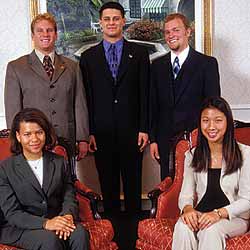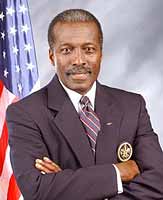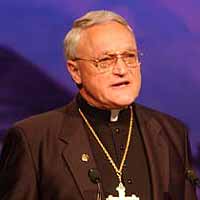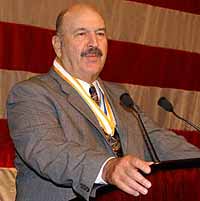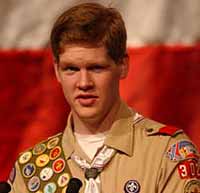![]() September 2002
September 2002
Celebration and Challenge
By Jon C. Halter
Photographs By John R. Fulton Jr., Roger Morgan, and Michael Roytek
At the BSA National Annual Meeting in New Orleans, Scouters reviewed the successes of 2001 and renewed their commitment to bring Scouting to every community and neighborhood in the nation.
- Silver Buffalo and Young American Awards
- Roy S. Roberts Is New BSA President
- Speakers Recall Lessons Learned From Scouting
- Highlights and Accomplishments
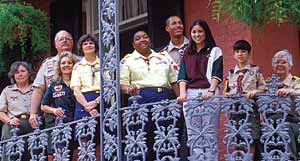 From the famous Royal Cafe restaurant, local Scouts, Scouters, and BSA visitors enjoy a bird's-eye view of the Crescent City's historic French Quarter. From left, Catherine Dolese, Ama, La.; Jeff Weidman, Metairie, La.; Dottie Brown, Tampa, Fla.; Mary Ann Price, Kennewick, Wash.; Elaine Francis, Southfield, Mich.; Eagle Scout Broque Thomas, Troop 185, New Orleans; Venturer Brigitte Faucheaux, Crew 230, and Webelos Scout Bryce Faucheaux, Pack 230, New Orleans; Mary Anne Rounds, Rockford, Ill. |
In welcoming the more than 2,000 Scouters and spouses to New Orleans in early June for the 83rd National Annual Meeting of the Boy Scouts of America, William M. Metcalf Jr., president of the Southeast Louisiana Council, noted with pride that his council had led the nation in growth in Cub Scouts in 2001, "with over 1,800 more young Cub Scouts than we had at the end of 2000."
The new Cub Scouts are "a diverse gumbo," Metcalf said, "—African-American, Anglo, French, Hispanic, Italian, Cajun, Asian...," representing the many and varied communities served by the Southeast Louisiana Council.
Louisiana's diversified population is no longer unusual, however, and similar ethnic and racial communities now exist in growing numbers across the United States. And at the New Orleans meeting, Scouters representing more than 300 local councils reaffirmed the BSA's goal (one of five critical issues in the 2002-2005 Strategic Plan) to—as stated in the 2001 Annual Report—"continue to be strongly committed to offering (our) program to all economic and racial groups," realizing "a representative membership that encompasses all ethnic groups."
Focus on new unit growth
 William M. Metcalf Jr. |
In 2000, at the start of his two-year term as president of the BSA, Milton H. Ward challenged Scouting to make the commitment to organize a Scout unit in every community and neighborhood in the nation. In New Orleans, in his final address as BSA president at the annual business meeting, Ward reported on the progress toward achieving this goal:
"No child who wants to join Scouting should be denied the opportunity because there is no unit in his area," Ward stressed. "I believe we have an obligation to serve those most in need, [and] across the nation today, Scoutreach professionals are indeed planting the seeds of Scouting in places where it has rarely been found in the past."
Ward introduced a special group of 32 Scouting professionals, from councils as distant as Hawaii and as near as Mississippi, who had been invited to share their innovative methods and success stories at the national meeting. (And, thanks to funds donated by Milton Ward and his wife, Adele, a similar group of outstanding Scoutreach executives will participate in future national meetings.)
 Milton H. Ward |
In 2001 the BSA "ended with the largest number of youth served ever—more than five million," Ward reported. "From 2000 to the end of April [2002], we added 25,886 new traditional units. That's a great sign, because it shows we can grow—and we still have plenty of people to serve."
New unit growth around the nation will receive a special boost in February, Ward added. A nationwide New Unit Video Conference, scheduled for Feb. 5, 2003, will provide a catalyst to support unit growth in every local council.
Ward also reported that "2001 was also a great year financially...Revenue was up 9 percent over 2000...total United Way income was up almost 4 percent, Friends of Scouting was up almost 5 percent, and our investment income was up 3.7 percent. Not bad for an economy in a slump."
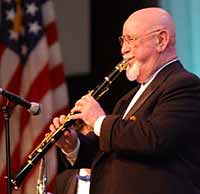 Pete Fountain, the "Ambassador of New Orleans Jazz," was a banquet highlight. |
Tools and methods for achieving the goals of the 2002-2005 Strategic Plan's five critical issues (Traditional Membership and Unit Growth, Scoutreach, Leadership, Marketing and Strategic Positioning, and Financial Development) were explored in five seminars and 17 elective workshops. The sessions covered a variety of topics, such as council commissioner leadership, council marketing and strategic planning, youth protection, Wood Badge for the 21st century, building effective local council Web sites, and new marketing and outreach programs and tactics for Cub Scouting, Boy Scouting, and Venturing.
In the exhibit area, Scouters visited with representatives from the National Council and other sources to learn about all areas of Scouting. Displays included the latest merchandise from the Supply Division; details on Cub Scouting, Boy Scouting, Venturing, and high adventure programs; resources available from Risk Management, Health and Safety, Scoutreach, Relationships, and Finance Support; a preview of the new National Scouting Museum in Irving, Tex.; and a sampling of the newest features from Boys' Life.
Past and future
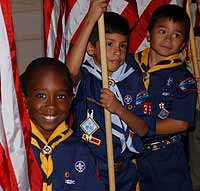 Southeast Louisiana Council Cub Scouts helped conduct meeting flag ceremonies. |
At the closing banquet and at the business session, Chief Scout Executive Roy L. Williams thanked all volunteers for their dedicated service. He told them that the BSA National Annual Meeting is "a celebration where we take the opportunity to recognize all of the hard work you put into this great movement."
He noted that "the BSA has a long tradition of exceptional volunteer leadership, [and] you're part of an unbroken string of leadership that has helped this movement to survive and prosper since 1910."
He was particularly proud of Scouting's response to the terrorist attacks of Sept. 11, Williams said. "The actions of our members show that the lessons of service and of patriotism our program tries to instill have had a very positive effect...Scouts volunteered and councils responded in a thousand different ways."
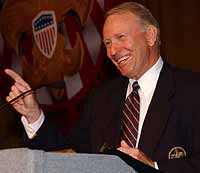 Roy L. Williams |
A national meeting is also an opportunity to focus on the challenges ahead, and Scouting's mission today is more important than ever, Williams said. "Scouting can't solve all the problems that come up in a young person's life, but we can equip them with tools they need to make better decisions—tools like honesty, integrity, respect—all the values that are found in the Scout Oath and Law."
Scouting's challenge, he said, "is to show schools, United Ways, foundations, our fellow business people, and all the others we talk to, show them how we can help, how effective our program is,...[that] our traditional programs of Cub Scouting, Boy Scouting, Varsity, and Venturing are still some of the best ways to equip kids with values."
Many Scouters may not realize the impact they have on young people, Williams said, "[but] chances are you've made a difference in more ways that you'll ever know...
"I'm proud of what you do," he concluded. "I'm proud of who you are and who we are...I'm proud to be a Scout and I know you are, too."
Jon C. Halter is the editor of Scouting magazine.
Silver Buffalo AwardsThe BSA honors adult leaders and young people for high achievement and service.
| ||||||||||||||
Roy S. Roberts Is New BSA PresidentThe BSA National Annual Meeting's closing banquet featured a tribute to Milton H. Ward, outgoing BSA president, and a welcome to incoming president Roy S. Roberts, as well as a videotaped message from the president of the United States, George W. Bush, expressing appreciation for the dedicated service by volunteer Scout leaders across the nation.
In his review of Milton Ward's two years as BSA president, Chief Scout Executive Roy L. Williams noted that at the beginning of his term, "Milt challenged the BSA to establish a unit in every neighborhood and community in the nation, [and] that challenge is now a part of our long-range strategic plan." Williams praised Ward for providing "unparalleled leadership to the Scoutreach program, making it possible for Scouting to touch the lives of many kids in some of our most difficult-to-serve urban and rural areas." He noted that Ward and his wife, Adele, have established a scholarship fund "to make it possible for needy children to experience the fun and excitement of our [national] high adventure bases." And the Milton and Adele Ward Fund provides "income to local councils to help them deliver the highest quality program," while the Ward Scoutreach Leadership Fund "made it possible for 32 Scoutreach executives to attend and take part in this—and future—annual meetings."
Meet the new presidentA recipient of the Silver Antelope and Silver Buffalo awards, new BSA president Roy S. Roberts became involved in Scouting 37 years ago. He was active in the Clinton Valley Council, Pontiac, Mich., and the Detroit Area Council prior to his election to the BSA National Executive Board in 1992. He has served on the nominating committee; as vice president for Exploring; vice president, relationships/marketing; chairman of the 1997 National Scout Jamboree; and, for the past two years, as executive vice president and as chairman of the Strategic Plan Committee. A former group vice president for North American vehicle sales, service, and marketing, General Motors Corporation, Roberts is now managing director of Reliant Equity Investors, Chicago, Ill. He is a member of the Society of Automotive Engineers and the Engineering Society of Detroit, and a recipient of the American Success Award (presented by former President George Bush in a White House ceremony) and the Detroit Chapter of the American Jewish Communities' Human Relations Award. Roberts has received the distinguished alumni award from Western Michigan University, where he is a trustee emeritus. He currently serves on the board of directors of the Burlington Northern Santa Fe Corporation, Abbott Laboratories, and on the national board of the College Fund/UNCF.
A 'golden age' of ScoutingIn his closing banquet remarks, Roberts told how he first became involved in Scouting as an adult. "A Scoutmaster friend invited me to speak with his Scouts about overcoming adversity and being the best you can be," he said. "It was such a rewarding experience that I've been hooked ever since." Scouting has "a great and glorious history," Roberts noted, "but this is our time, [and] there has never been a greater need for Scouting [than now]...With your help, we will make this the golden age' of Scouting... "I am looking forward to the next two years because we're going to do great things together. I am proud of this movement, I am proud of our work for young people, and I am proud to serve as your president." |
Speakers Recall Lessons Learned From Scouting
The Duty to God Breakfast and the Americanism Breakfast (hosted by the National Eagle Scout Association) are two highlight sessions at every BSA National Annual Meeting. In New Orleans, the Duty to God speaker was Bishop Gerald A. Gettelfinger of the Catholic Diocese of Evansville, Ind. Active as chaplain and committee member for Troop 174 (chartered to Immaculate Heart of Mary Church, Indianapolis, Ind.), Bishop Gettelfinger is a recipient of the Silver Beaver Award and the Silver Antelope Award. Recalling his past experiences as a parish priest and in Scouting (in particular as a crew member on mountain treks at Philmont Scout Ranch in New Mexico), he described how "the God who calls us to duty" can be perceived in different ways at different times. For example, the "God of blindness" teaches us to be aware of things we might not otherwise notice, while the "God who hides" will "test if we are paying attention" to the fact that "no matter how rich or how poor, somewhere in [every] person, God resides." The "God of joy and wonder...urges us to do our duty to recognize his presence in the beauty of the great world around us," while the "God of reflection" causes us to consider "what [we] are about and to walk together consciously and attentively." The "God that hikes" has "assigned us to a trek and to a crew...Each of us knows that God in different ways, but we know that God expects each crew member to do his or her part." ***
"I'm in my 70s now, and my Scouting background is just as strong as it was as I came up through life," he told the breakfast audience. "Eagle Scout [can mean] as much to a young person—as it did to me—as my high school diploma or college diploma." "I've always believed [that] one of the things that makes Scouting work is that you remember it," he said. He recited the Scout Law and described the nature and meaning of the virtues in each point, from Trustworthy ("If you don't have that, you can't go very far in organized society...") to Reverent ("From first to last, this may be the most important, the ability to believe in a greater power, something bigger than you are...").
"One great thing about Scouting is that there are at least two parts to every lesson that leaders teach," said Zachary, now a student at Harvard University. "The lesson is very valuable, but there's also the experience of learning, actual contact with the teacher." Scouting teaches skills and values, he noted. "Its instructors become role models and...it [teaches] values and morals, such as kindness, loyalty, and bravery. In short, it creates capable young men who are also good young men." Zachary also pointed out that Scouting builds self-confidence. "Much of Scouting is based on teamwork, but much of it is based on self-reliance. Boys find out that when they focus their attention, many limits will fall away, and they can accomplish more than they ever dreamed possible...I know that without my experiences that I had as a Boy Scout, I wouldn't be the person I am today." |
Highlights and AccomplishmentsThe following were some BSA accomplishments for 2001 highlighted at the National Annual Meeting:
|
September 2002 Table of Contents
Copyright © 2002 by the Boy Scouts of America. All rights thereunder reserved; anything appearing in Scouting magazine or on its Web site may not be reprinted either wholly or in part without written permission. Because of freedom given authors, opinions may not reflect official concurrence.
| The Boy Scouts of America | http://www.scouting.org |






